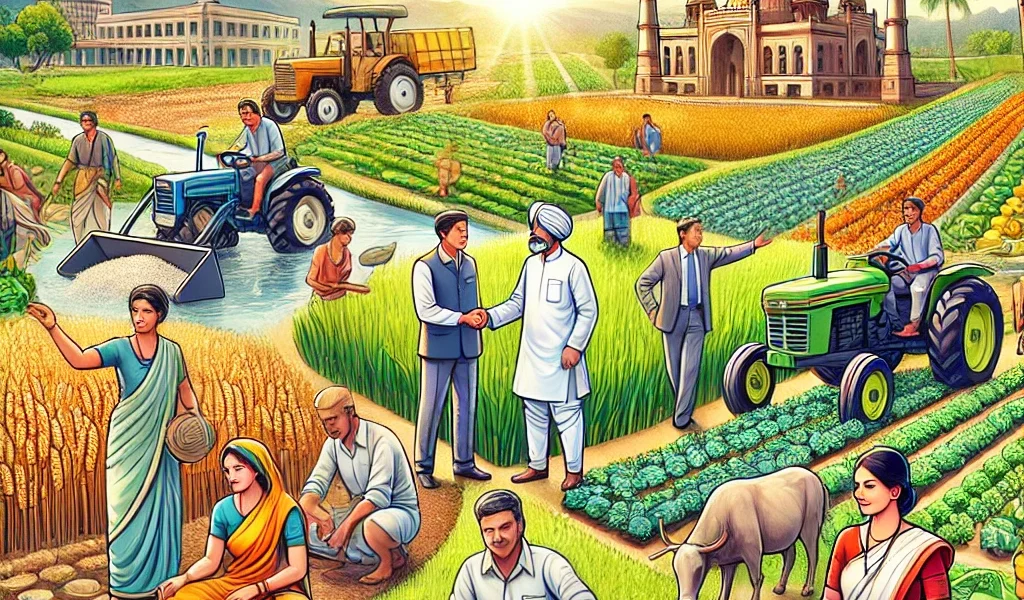Introduction
Agriculture is the backbone of rural economies, and governments at both the central and state levels introduce various schemes to support farmers. These schemes aim to provide financial assistance, subsidies, insurance, and technological advancements to help farmers improve productivity and income.
In this blog, we will explore state-wise agricultural schemes in India, highlighting the key benefits and eligibility criteria farmers need to know.
Importance of State-Wise Agricultural Schemes
- Tailored Solutions: Different states have distinct climatic conditions and agricultural challenges. State-specific schemes address localized issues.
- Financial Assistance: Many states offer subsidies, low-interest loans, and financial aid to small and marginal farmers.
- Sustainability: Schemes often promote organic farming, water conservation, and climate-resilient agriculture.
- Market Linkages: Some programs help farmers connect directly with buyers, reducing dependency on middlemen.
State-Wise Agricultural Schemes
1. Maharashtra: Balasaheb Thackeray Krishi Sanjivani Yojana
- Objective: Provides financial aid for farmers affected by climate change.
- Key Benefits:
- Soil and water conservation projects.
- Financial assistance for small and marginal farmers.
- Eligibility: Farmers practicing rain-fed agriculture or affected by droughts.
2. Uttar Pradesh: Kisan Kalyan Mission
- Objective: Aims to double farmers’ income by promoting modern agricultural techniques.
- Key Benefits:
- Training on advanced farming techniques.
- Financial aid for agri-entrepreneurs.
- Eligibility: Open to all registered farmers in UP.
3. Punjab: Bhavantar Bharpai Yojana
- Objective: Ensures minimum price compensation for crops.
- Key Benefits:
- Farmers receive compensation if market prices drop below MSP.
- Covers crops like maize, potatoes, and onions.
- Eligibility: Small and medium-scale farmers growing specific crops.
4. Tamil Nadu: Chief Minister’s Dry Land Development Mission
- Objective: Supports dry land farming with water conservation and irrigation projects.
- Key Benefits:
- Drip irrigation and rainwater harvesting assistance.
- Financial aid for organic farming.
- Eligibility: Farmers in dry land regions of Tamil Nadu.
5. Karnataka: Raitha Siri Scheme
- Objective: Encourages millet farming for sustainable agriculture.
- Key Benefits:
- Financial assistance of ₹10,000 per hectare.
- Organic farming and processing unit support.
- Eligibility: Millet farmers in Karnataka.
6. Rajasthan: Mukhyamantri Krishi Saathi Yojana
- Objective: Supports farmers with subsidies for agricultural machinery.
- Key Benefits:
- 50% subsidy on tractors, harvesters, and irrigation systems.
- Insurance coverage for farm produce.
- Eligibility: Small and medium-scale farmers.
7. Gujarat: Krishi Sahay Yojana
- Objective: Provides financial assistance to farmers during natural calamities.
- Key Benefits:
- Compensation for crop loss due to floods or droughts.
- ₹20,000 per hectare assistance.
- Eligibility: Farmers affected by natural disasters.
8. West Bengal: Krishak Bandhu Scheme
- Objective: Provides financial support and life insurance for farmers.
- Key Benefits:
- ₹10,000 per annum financial aid for farmers.
- ₹2 lakh life insurance for registered farmers.
- Eligibility: Small and marginal farmers of West Bengal.
9. Madhya Pradesh: Mukhya Mantri Krishak Samriddhi Yojana
- Objective: Supports farmers in improving productivity and market linkage.
- Key Benefits:
- Direct benefit transfer (DBT) of ₹200 per quintal for wheat and rice.
- Training programs for modern agriculture techniques.
- Eligibility: Farmers growing staple crops in MP.
10. Bihar: Bihar Rajya Fasal Sahayata Yojana
- Objective: Provides financial aid for crop losses.
- Key Benefits:
- Compensation of ₹7,500 per hectare for partial damage.
- ₹10,000 per hectare for total crop loss.
- Eligibility: Farmers affected by floods and droughts in Bihar.
How to Apply for State Agricultural Schemes?
Step 1: Check Eligibility
- Visit the official agricultural department website of your state.
- Check whether your crop and farm size meet the criteria.
Step 2: Gather Required Documents
- Aadhaar Card and land ownership proof.
- Bank account details for direct benefit transfers.
- Crop registration certificates (if applicable).
Step 3: Apply Online or Offline
- Online: Most state governments have dedicated portals for agricultural schemes.
- Offline: Visit local agricultural offices or cooperative banks.
Step 4: Track Application Status
- Use the application reference number to track status online.
- Contact local agricultural officers for assistance.
Key Takeaways for Farmers
- Stay Updated: New schemes are introduced periodically. Regularly check government websites.
- Register Your Farm: Many benefits are available only to registered farmers.
- Utilize Financial Aid Wisely: Invest in better seeds, equipment, and sustainable practices.
- Seek Assistance: Agricultural extension offices provide free guidance on scheme applications.
Conclusion
State-specific agricultural schemes play a crucial role in supporting farmers by offering financial aid, subsidies, and training. Understanding the benefits and eligibility criteria of these schemes helps farmers make informed decisions to enhance productivity and income.
By staying informed and actively applying for these schemes, farmers can leverage government support to build a more sustainable and profitable agricultural future.




